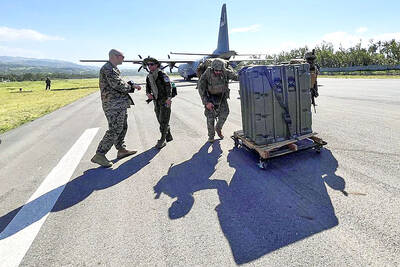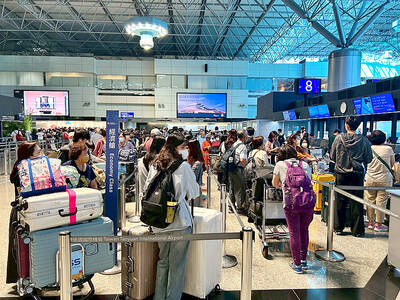The Tourism Bureau is to obtain loans from Bank of Taiwan and Union Bank of Taiwan, totaling NT$5.9 billion (US$210.65 million), to replenish the Tourism Development Fund, which was depleted at the end of last year.
This is the first time since the fund’s establishment in 1999 that the bureau has needed to take out bank loans to replenish it.
The fund was created to promote tours to Taiwan, the bureau said.
Ninety percent of the fund’s revenue comes from the airport service fee paid by outbound travelers, it said, adding that the fund receives half of each NT$500 fee.
However, borders controls imposed to contain the spread of COVID-19 dramatically reduced the number travelers, which sent fund revenue plummeting to almost zero, it added.
The bureau said that it was forced to take out bank loans to continue promoting tours to Taiwan.
The borrowed money could become available next month as the bureau said it plans to sign the loan contracts with the two banks at the end of this month.
The loans total NT$5.9 billion, with NT$3.21 billion allocated for the second half of this year and NT$2.68 billion for the first six months of next year.
The money would be used to cover the “Taiwan Tourism 2025” campaign, but could not be used for relief payments or subsidies to tour operators, the bureau said.
Once the nation’s borders reopen and there are once again travelers to pay the airport service fee, the loans would be repaid, bureau officials said.
Before the borders reopen, the bureau would carefully manage the amount borrowed from banks to avoid large interest payments, they said.
Before COVID-19, the fund grew each year thanks to a surge in travelers. At one point, the bureau used the fund to subsidize domestic tourism during off-peak travel times.
Fund expenditures also ballooned over the past few years, increasing to NT$21.3 billion.
The fund was also used to subsidize travel operators affected by the pandemic and to support government infrastructure projects.
The fund had dwindled to NT$176 million by the end of last year.

Three batches of banana sauce imported from the Philippines were intercepted at the border after they were found to contain the banned industrial dye Orange G, the Food and Drug Administration (FDA) said yesterday. From today through Sept. 2 next year, all seasoning sauces from the Philippines are to be subject to the FDA’s strictest border inspection, meaning 100 percent testing for illegal dyes before entry is allowed, it said in a statement. Orange G is an industrial coloring agent that is not permitted for food use in Taiwan or internationally, said Cheng Wei-chih (鄭維智), head of the FDA’s Northern Center for

The Chinese military has built landing bridge ships designed to expand its amphibious options for a potential assault on Taiwan, but their combat effectiveness is limited due to their high vulnerability, a defense expert said in an analysis published on Monday. Shen Ming-shih (沈明室), a research fellow at the Institute for National Defense and Security Research, said that the deployment of such vessels as part of the Chinese People’s Liberation Army (PLA) Navy’s East Sea Fleet signals a strong focus on Taiwan. However, the ships are highly vulnerable to precision strikes, which means they could be destroyed before they achieve their intended

LOOKING NORTH: The base would enhance the military’s awareness of activities in the Bashi Channel, which China Coast Guard ships have been frequenting, an expert said The Philippine Navy on Thursday last week inaugurated a forward operating base in the country’s northern most province of Batanes, which at 185km from Taiwan would be strategically important in a military conflict in the Taiwan Strait. The Philippine Daily Inquirer quoted Northern Luzon Command Commander Lieutenant General Fernyl Buca as saying that the base in Mahatao would bolster the country’s northern defenses and response capabilities. The base is also a response to the “irregular presence this month of armed” of China Coast Guard vessels frequenting the Bashi Channel in the Luzon Strait just south of Taiwan, the paper reported, citing a

About 4.2 million tourist arrivals were recorded in the first half of this year, a 10 percent increase from the same period last year, the Tourism Administration said yesterday. The growth continues to be consistent, with the fourth quarter of this year expected to be the peak in Taiwan, the agency said, adding that it plans to promote Taiwan overseas via partnerships and major events. From January to June, 9.14 million international departures were recorded from Taiwan, an 11 percent increase from the same period last year, with 3.3 million headed for Japan, 1.52 million for China and 832,962 to South Korea,